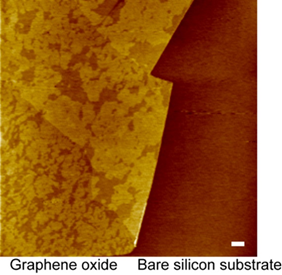

Concentration of cell membrane components with nanocarbon materials
Localization of lipid bilayer domain on graphene oxide Ryugo Tero
A research team from the Department of Applied Chemistry and Life Science at Toyohashi University of Technology (Professor Ryugo Tero et al.) discovered a phenomenon in which specific lipids are concentrated on graphene oxide in multi-component lipid bilayers, a model for cell membranes. They also clarified the mechanism by which the components of "lipid rafts" (where important cell membrane reactions such as neurotransmission and metabolism occur) gather, owing to the surface characteristics of graphene oxide. This is expected to be useful as a fundamental technology for the concentration and separation of lipids and membrane proteins in cell membranes, which are important research targets in the fields of medicine and drug discovery.
All the transportation of substances, information, and energy inside and outside the cell that is necessary for vital activities is carried out through the cell membrane. These transportations are deeply involved in neurotransmission, metabolism, and viral infections, making them important research targets in the biology, medicine, and drug-discovery fields. The basic structure of the cell membrane is a lipid bilayer, in which specific lipids and membrane proteins are assembled through diffusion and aggregation of molecules within the membrane to control and improve the efficiency of reactions occurring in the cell membrane. Such regions are called lipid domains, a typical example of which is "lipid raft", which is rich in sphingolipids and cholesterol. New technologies for controlling and arranging the positions of lipid domains on a solid substrate are demanded for the biosensing and screening of lipids and membrane proteins.
This research team fabricated an artificial lipid bilayer on a graphene oxide monolayer deposited on a silicon substrate. They discovered for the first time that the lipid domains are concentrated on graphene oxide. Graphene oxide has a structure in which hydrophilic oxygen functional groups are added to graphene (a monoatomic sheet material of carbon).

Atomic force microscope image of the two-component lipid bilayer formed on the graphene oxide deposited on a silicon substrate. Gel phase domains are concentrated on the graphene oxide (left) and are not observed on the silicon substrate (right). Scalebar: 500 nm.
In a two-component lipid bilayer consisting of two types of phosphatidylcholines with different fluidities, the majority of the low-fluidity gel phase domains in the lipid bilayer membrane gathered on the graphene oxide. In a three-component mixed lipid bilayer membrane of sphingolipids, cholesterols, and phosphatidylcholine, many lipid raft components were present on the graphene oxide.
Professor Ryugo Tero, the leader of the research team, explained as follows: "Regardless of the lipid composition, the less fluid lipid domains clustered on the graphene oxide. This is due to the presence of a mixture of hydrophilic and hydrophobic regions on the graphene oxide surface on a nanometer scale. The initial process of the domain formation in the lipid bilayer occurred preferentially in the hydrophobic regions of the graphene oxide."
By controlling the position of lipid domains on a solid substrate, membrane proteins with high affinity to the lipids can be placed in the same location, which is expected to be useful as an elemental technology for biosensors and screening technologies targeting membrane proteins. Furthermore, the research team believes that the same method can be used to collect biochemically important lipid components such as glycolipids as well as the lipid raft. They expect that this will be useful in the development of techniques for concentrating and purifying the rare lipids and membrane proteins in cell membranes.
Reference
Ryugo Tero, Yoshi Hagiwara and Shun Saito (2023). Domain Localization by Graphene Oxide in Supported Lipid Bilayers, International Journal of Molecular Sciences, 24 (9), 7999.
https://doi.org/10.3390/ijms24097999
ナノカーボン材料で細胞膜の成分を濃縮する
脂質二重膜内ドメインの酸化グラフェン上への局在化 手老 龍吾豊橋技術科学大学応用化学・生命工学系の研究チーム(手老龍吾教授ら)は、細胞膜モデルとなる多成分脂質二重膜内において、酸化グラフェン上に特定の脂質が濃縮される現象を見出しました。また、神経伝達や代謝などの重要な細胞膜反応がおきる場である「脂質ラフト」の成分が、酸化グラフェンの表面特性によって集められるメカニズムを明らかにしました。このことは、医療・創薬分野の研究対象として重要視される細胞膜内の脂質や膜タンパク質を濃縮・分離するための要素技術として役立つことが期待されます。
生命活動に必要な細胞内外での物質・情報・エネルギーのやり取りは全て、細胞膜を通して行われています。これらは神経伝達や代謝、またウイルス等の感染などに深く関わることから、生物学・医療・創薬分野での重要な研究対象です。細胞膜の基本構造は脂質二重膜であり、膜内での分子の拡散・凝集を通して特定の脂質や膜タンパク質が集まることで、細胞膜で起きる反応の制御や効率化がなされています。このような領域を脂質ドメインと呼び、その代表例がスフィンゴ脂質やコレステロールに富んだ「脂質ラフト」です。脂質や膜タンパク質を対象としたバイオセンシングやスクリーニングのためには、固体基板上に脂質ドメインの位置を制御して配置する技術が求められています。
研究チームは、単層の酸化グラフェンを担持したシリコン基板上に人工脂質二重膜を作製することで、酸化グラフェン上に脂質ドメインが濃縮されることを初めて見出しました。酸化グラフェンは、炭素の単原子シート状材料であるグラフェンに親水的な酸素官能基が付加した構造を持ちます。
流動性の異なる2種類のフォスファチジルコリン(phosphatidylcholine)を混合した脂質二重膜では、流動性の低いゲル相のドメインの多くが酸化グラフェン上に集まりました。スフィンゴ脂質、コレステロール、フォスファチジルコリンの3成分混合脂質二重膜の場合には、「脂質ラフト」の成分が酸化グラフェン上に多く存在しました。
「脂質の組成にかかわらず、流動性の低い方の脂質ドメインが酸化グラフェン上に集まります。これは、酸化グラフェンの表面には親水性領域と疎水性領域がナノメートルスケールで混ざって存在していることが原因です。脂質二重膜内にドメインが作られる最初のプロセスが、疎水性領域で優先的に起きるのです。」と研究チームのリーダーである手老龍吾教授は説明します。
固体基板上で脂質ドメインの位置を制御することで、その脂質と親和性の高い膜タンパク質も同じ場所に配置することができ、膜タンパク質を対象としたバイオセンサやスクリーニング技術の要素技術として役立つことが期待されます。また、研究チームは、「脂質ラフト」の成分だけでなく、糖脂質など生化学的に重要な脂質のドメインも同じように捕集できると考えており、細胞膜内に含まれる希少な脂質や膜タンパク質を濃縮・精製する技術の開発にも役立つと期待しています。
Researcher Profile

| Name | Ryugo Tero |
|---|---|
| Affiliation | Department of Applied Chemistry and Life Science |
| Title | Professor |
| Fields of Research | Surface Physical Chemistry |
